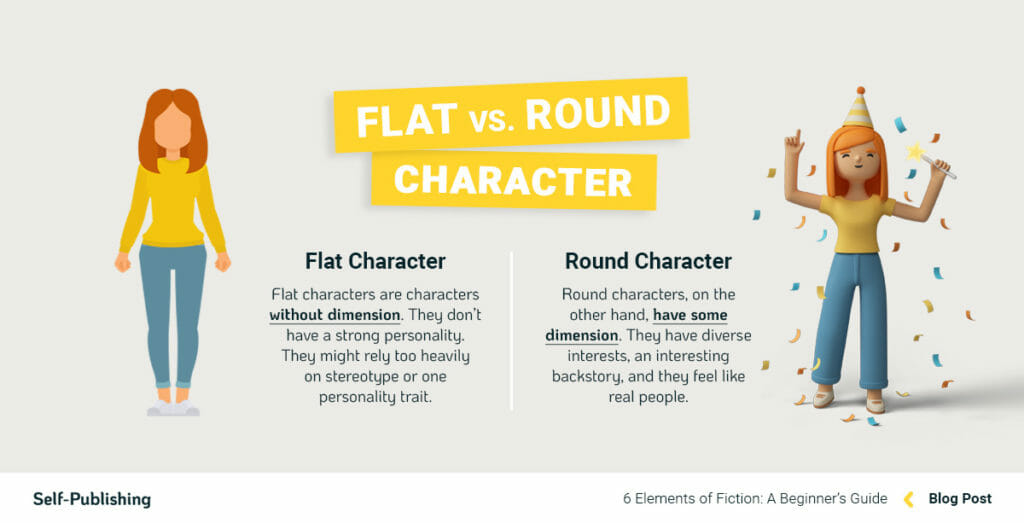It’s easy to lose track of the fundamentals in the dearth of writing advice currently circulating the web. If you’re looking for some universal, down-to-earth help on making your fiction the best it can be, then it might help to take a look at the basics, starting with the six elements of fiction.
In this article, we’ll talk about what they are, how to practice with them in your own work, and give examples of each. If you’re a beginner, this is a great place to start taking a closer look at the components of your stories. If you’re an expert, this is your chance to hone some basic skills!
Without further ado, let’s get started!
Here are six elements of fiction to know:
Character
One of the first elements of fiction most encounter. Characters are the people the reader follows through your story. They’re the ones we watch grow and develop. We get attached to your characters, and even if you’ve got an interesting premise and setting, a flat character can turn a reader off immediately.
Here are a few things to keep in mind when you’re creating characters for your story:

Flat vs. Round
In general, there are flat and round characters. You want round characters, and you want to avoid flat ones as much as possible.
Flat characters are characters without dimension. They don’t have a strong personality. They might rely too heavily on stereotype or one personality trait. Round characters, on the other hand, have some dimension. They have diverse interests, an interesting backstory, and they feel like real people.
Your characters should be complicated. Give them interests, motivations, and complex characteristics. People contain multitudes! Nobody in real life is just one thing, and your characters shouldn’t be, either.
Want vs. Need
It’s important to identify what your character wants—-after all, the story should follow them trying to pursue it! But it’s also important to know what your character really needs, and to know whether these things line up.
For example, in Avatar the Last Airbender, Zuko wants to recapture the Avatar and regain his honor. What he really needs is to accept himself and help Aang restore balance to the world.
Plot
A story needs, well, a story. Learning to use this as one of the key elements of fiction, the plot of your novel is made up of the events that take place. Everything that happens is a part of the plot! This is one of the most foundational of the elements of fiction. There are plenty of different ways you can structure your novel to map out the action, but these tips will be helpful no matter what structure you choose.
Cause and Effect
When you sit down to write your scenes, keep your character’s goals in mind. Why are they about to do what they’re doing?
It’s also important that something changes in each scene. Often, when a reader says ‘nothing happened’ in a scene, it’s because there was no change at all in the status quo.
Your character’s actions should impact the plot, and the plot points should be impactful to the overall story.
Conflict
Conflict is the driving source of tension in your novel, and it’s what will keep readers hooked throughout the story. In a romance, the conflict is “will they end up together?” In a mystery, it’s usually “who did it?”
Your conflict comes from the challenges your characters face trying to pursue their goal. If you’re getting feedback that your novel reads too slowly or if you feel that you’re having a hard time figuring out what your characters should do next, throw them some conflict! Give them a problem to solve that’s rooted in their personalities, flaws, and desires.
Know Your Ending
Some people prefer not to outline, and some people swear by it, but the truth is this: it’s much easier to get where you’re going if you know where you’re headed.
You don’t have to have the ending exact, but at least having an idea of how it ends—-do they end up together? Did the butler commit the murder?—will help you plot the rest of your novel.
Point of View
The point of view in a novel is the vantage point from which we read. It’s the lens being used to convey information to the reader. There are three types of POV: first, second, and third, which third being divided into limited and omniscient.
First Person
First person means we’re inside the main character’s head using the pronoun “I.” This is the closest possible point of view, as it means we can never leave the main character’s head for the entire story. We’re locked in, and we’re here for the ride.
First person is often used in young adult literature, but it’s also pretty common in character-driven adult fiction like literary fiction or realistic fiction. It creates an immediate sense of intimacy just by putting us right in the character’s head.
Second Person
Second person is the “you” point of view. This sometimes gets confused with epistolary books, which are actually technically first person, but here’s how you tell them apart: in the second person, “you” is the main character, not the addressee. There will be no mention of an “I,” since we’re reading from the perspective of “you.”
In an epistolary book, though, we’re reading from the perspective of the person writing the letter. They might use “I,” and they’re addressing “you.”
Third Person Limited
Third person limited means we’re reading from the perspective of a specific character, and we’re using he, she, or they. Because the perspective is limited, we can only see inside our narrating character’s head, and we don’t get the thoughts or perspectives of other characters.
Third person close is a subtype of third person limited. In third person close, we’re in our narrator’s head just as intensely as we might be if we were in first person, but we’re using third person pronouns.
Third Person Omniscient
Third person omniscient is the only point of view where we get more than one character’s perspective in a scene. This point of view also uses third person pronouns.
Third person omniscient isn’t the same as having alternating POV in a novel. You might have chapters of a book from different characters’ perspectives, but in each of these chapters, we’re usually reading from that character’s perspective.
Because you’re able to see everyone’s perspective, motives, and thoughts, this perspective can make it difficult to have meaningful conflict. But it’s not impossible!
Setting
Where does your novel take place? The answer will dramatically alter your characters, plot, and even genre, so it’s important to consider when you’re working on your outline. Here are a few things to keep in mind when considering the setting of a story:
Time Period
In the same way that we need to know where your story takes place, we need to know when it takes place. Is your story set in the eighties? If so, you’ll need to take that into consideration when you’re plotting your murder mystery.
Even if you’re writing a fantasy novel, it’s still good to keep in mind when the story happened in that universe. You don’t necessarily need to go the route of J.R.R. Tolkein and have your whole country’s history mapped out, but knowing the general chronology will make a big difference in the feel and tone of your story.
Location
This is the most simple element of setting: where is it?
If you’re writing realistic fiction, consider what city or state you’re working with. What’s life like there? How do the struggles unique to that location play a part in your story?
If you’re writing fantasy and you’ve got some worldbuilding to do, geography is hugely important. A port city will look radically different from a desert city, and both will be way different than a village in the tropics.
Style
A style is the words, diction, syntax, and structure that a writer uses. Like everything else on this list, it’ll vary a lot by genre. This one is a little tricky, out of all the elements of fiction this may be the most subjective. Basically, it takes time to hone your specific style. Do you favor shorter, more brutal sentences, like Cormac McCarthy, or do you like more colorful descriptions and a more academic tone, like Donna Tartt?
There’s two big things you can do to lock down your style.
First, read as much as you can and as broadly as possible. We often write what we read, especially when we’re starting out, so it’s good to have a wide variety coming in.
Second, practice writing as much as possible. The more you practice, the more you’ll shake copying other authors’ styles and start developing and honing your own.
Theme
When we talk about the themes of a story, we’re talking about what the story was ‘about.’ Theme is the recurring issues brought up in a story. A theme of many superhero movies is sacrifice—-our hero has a new ability to stop evil, but at a great personal cost. A theme of Lord of the Rings is the effect of war on people. Frodo is unable to return to the Shire after what he’s seen and has to go West to be at peace.
Read broadly in the genre you intend to write. What are the sorts of themes being explored? You don’t have to necessarily touch on the same topics, but it’s good to know what sort of tone you want to strike. A romance novel might not be the place for a gritty examination of climate change, for example.
When you’re writing, keep in mind what this story is about—-not just at a surface level, but on an analytic, symbolic level. What does the end imply? How do your characters change, and how does that impact the themes you’re exploring?
Every Element of Fiction A Writer Could Consider
Feel free to use this article as a reference point when you’re stuck on a particularly tricky scene or while you’re outlining.
Keeping these six elements of fiction in mind will keep your storytelling fresh, and wherever your story goes, these tips will be there for you!

